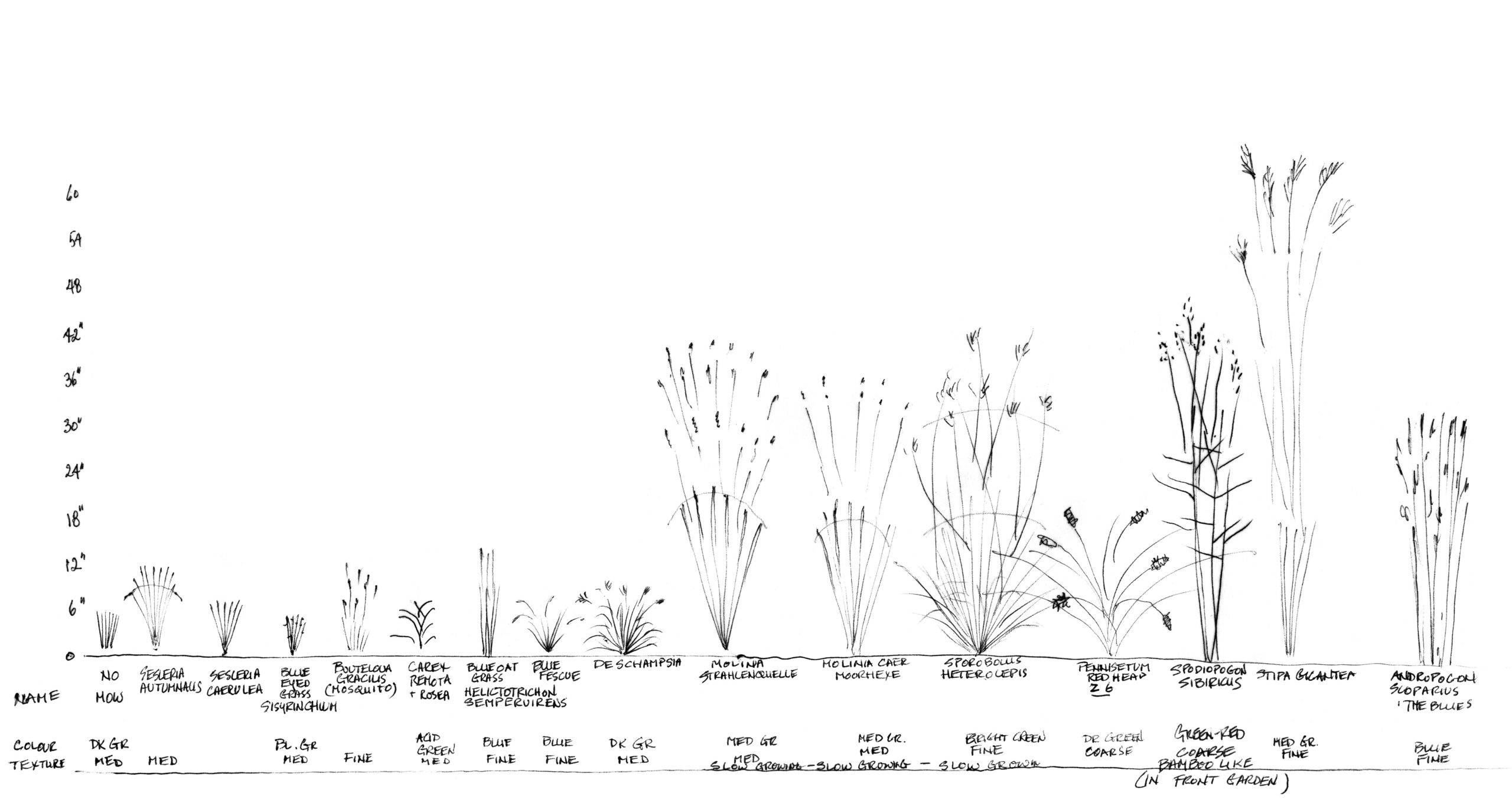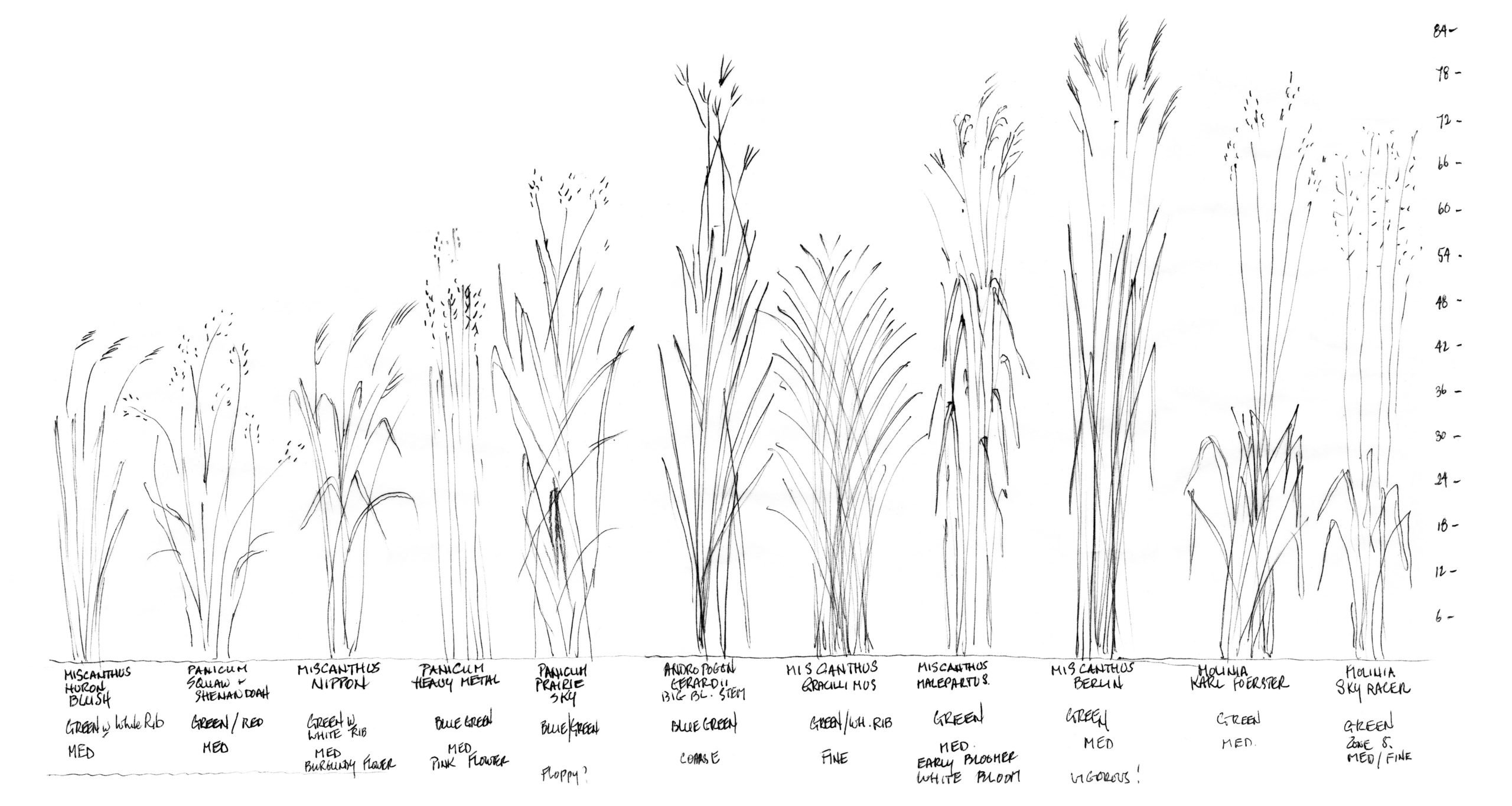Splendour in the Grass
Mono gardener Misha Dubbeld’s newest garden, full of swaying grasses and anchored by a spillway of field rocks, was carved out of a windswept field.
In the spring of 2015, this magazine featured the perennial garden of Misha Dubbeld. Lush and abundant in colourful, artfully curated blooms, it is an exceptional classic country garden surrounding a classic Ontario Gothic farmhouse in Mono. But even then, Misha was laying the carefully considered bones for a new garden vernacular on a much broader landscape.
Six years later, we are revisiting Misha to see how her vision has come to fruition.
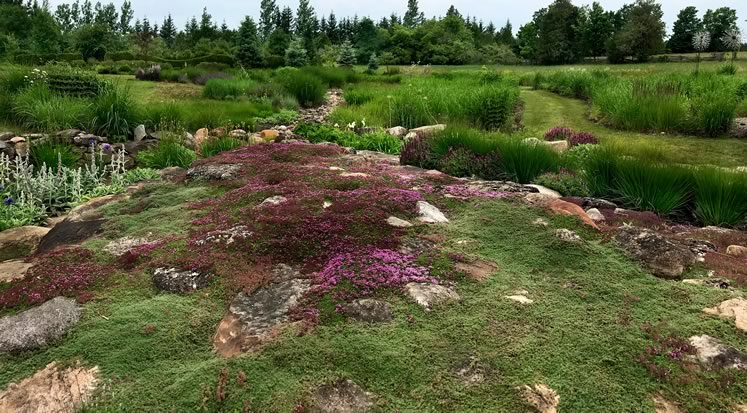
Early in the summer, a wide stone mound at the mouth of the spillway is covered in an inviting and fragrant carpet of blooming thyme. Photo by Rosemary Hasner / Black Dog Creative Arts.
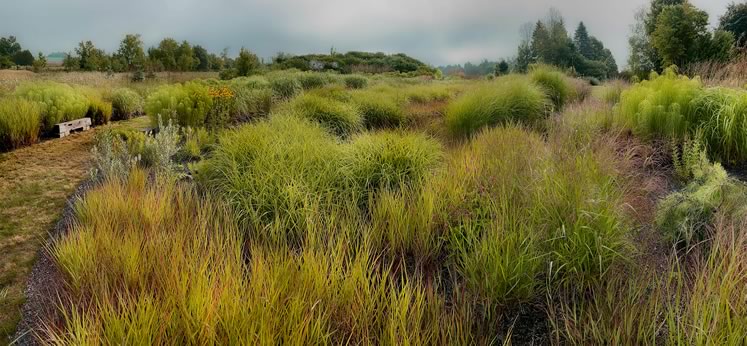
On a misty August morning, the grass garden is an ethereal palette of green form and hue. Photo by Rosemary Hasner / Black Dog Creative Arts.
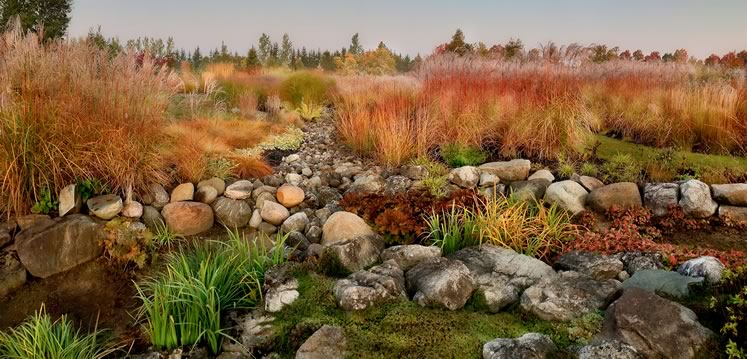
In autumn, the stone spillway, or dry creek, that forms the central axis of Misha Dubbeld’s expansive grass garden in Mono is lined by a brilliant display that includes several varieties of glowing copper-red Miscanthus sinensis. Photo by Rosemary Hasner / Black Dog Creative Arts.
Located on two acres of what was largely a flat and windswept field north of the house, the mature garden is now a moody, motion-filled canvas of swaying, textural grasses that line a crafted spillway of field rocks. The whole expanse is defined and protected by a stone wall to the east and a sculptural double cedar hedge to the west, and surrounded by an arboretum of unusual conifers.
In conceiving the garden, Misha says, “I wanted to burst out and take on something that was truly, for me, a challenge. What would work on a piece of land that had been a sand ring for horses – without changing too much about the soil, and without requiring a ton of inputs of water and topsoil? That was a big part of the decision to do a grass garden.”
That, and her admiration for the work of Dutch master gardener Piet Oudolf, whose sweeping and painterly naturalized gardens were then gaining recognition in North America, including his famous garden on the High Line, a more than two-kilometre-long former industrial viaduct in New York City.
Rather than the pretty, smaller vignettes that defined her perennial garden, Misha says she wanted to “feel big sky, big waves, big swathes of things.”
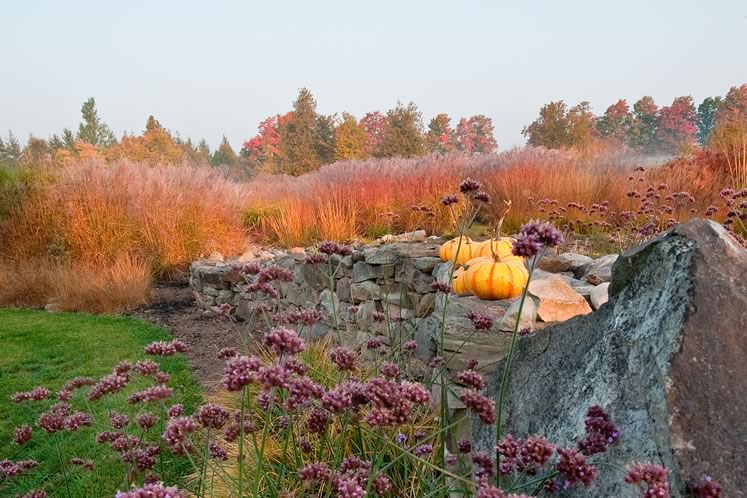
Against a backdrop of shimmering orange-gold grasses, plump squashes add a note of seasonal whimsy to the sweeping stone wall on the north-east side of the garden. Photo by Rosemary Hasner / Black Dog Creative Arts.
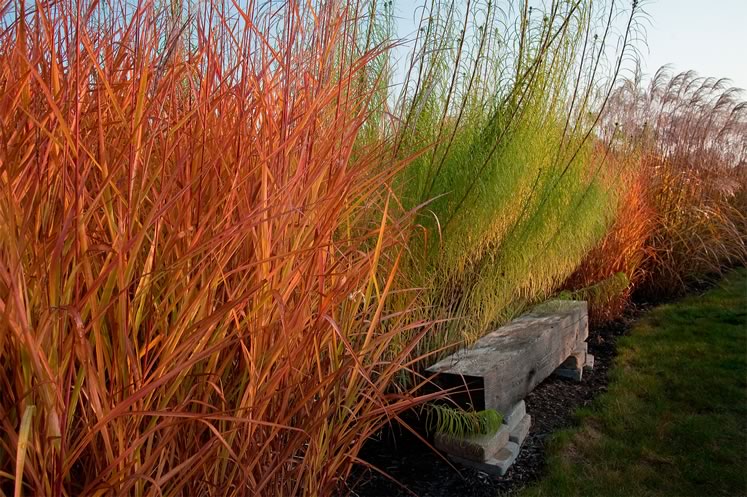
A rustic bench is shaded by Miscanthus sinensis ‘Malepartus’ and Helianthus salicifolius. Photo by Rosemary Hasner / Black Dog Creative Arts.
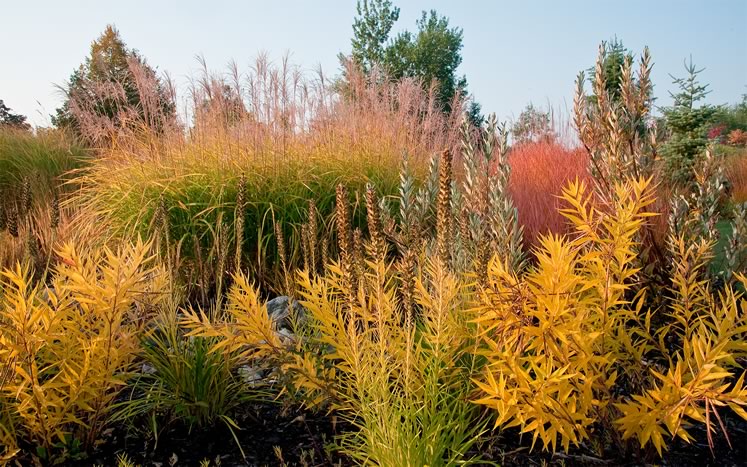
The brilliant yellow of Liatris spicata and Amsonia hubrechtii glow in the autumn sun. Photo by Rosemary Hasner / Black Dog Creative Arts.
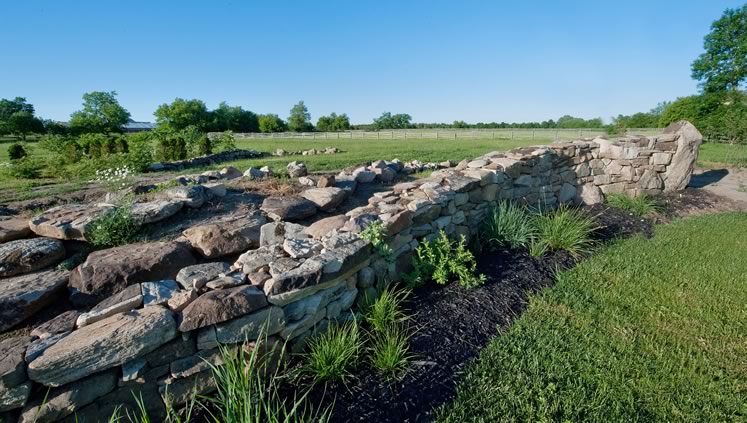
The bones of the garden as Misha began to lay it out six years ago. Photo by Rosemary Hasner / Black Dog Creative Arts.
And that is exactly what she has achieved. Filled with enticing shapes and textures throughout the year, the grasses are most resplendent in the autumn when they form a high, undulating sea of gold, bronze and copper that seduces a visitor into an expansive and magical dreamscape of colour and form.
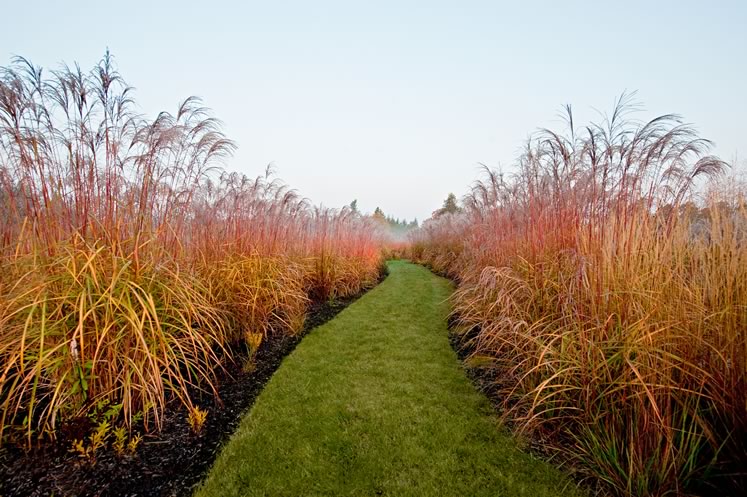
A mowed path contrasts sharply with tall grasses that flank it. Photo by Rosemary Hasner / Black Dog Creative Arts.

Misha’s Portuguese podengo pequeno, Pip, appreciates the garden’s stone wall as a lookout. Photo by Rosemary Hasner / Black Dog Creative Arts.
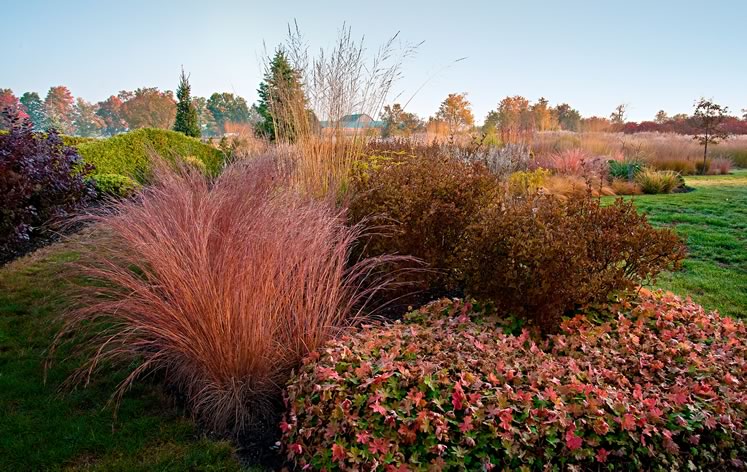
The garden’s fall colours range from lime green to cherry red. Photo by Rosemary Hasner / Black Dog Creative Arts.
More Info
Gems and thugs of the grass garden
Choosing the right grass for the right location can save you heartbreak later. Misha Dubbeld offers these tips to get you started.
All grasses flower and seed and many propagate rapidly by runner; ergo, their success throughout the world from the prairies to the steppes to hayfields, lawns and the margins of brook and forest. Tough plants on the whole, grasses grow in sand, clay or the humus-rich soils of well-tended domestic gardens. Once established, they can be hard to transplant.
All the following will prosper in zone 4. On very sandy, dry soil they may be a bit shorter than on rich, moist soil. But grow they will.
The gems
Molinia caerulea (aka moor grass) are the nobility of the warm season grasses. The flowers of ‘Skyracer’ rise to 8 feet. ‘Strahlenquelle’ and ‘Moorhexe’ are more petite but equally beautiful. All are sun lovers that thrive in hot dry conditions.
Miscanthus sinensis, a robust grass, is another giant of the garden. ‘Floridula’ can grow to 8 to10 feet in the harshest conditions. The shorter (4 to 5 feet) ‘Morning Light’ forms a fountain-shaped clump.
Calamagrostis acutiflora ‘Karl Foerster,’ ubiquitous in city parks and at Tim Hortons coffee shops, is a cool season grass sprouting fresh vertical stems in May and blooming in June. By itself in tidy rows, it has been overused, but interplanted with other grasses and perennials, it is a strong vertical focal point throughout the seasons.
Another cool season grass is Sesleria heufleriana. Short (15 inches tall), it flowers in late spring with an almost black flower/seed pod.
Schizachyrium scoparium, aka little bluestem, looks so ordinary for most of year it could be overlooked. But come late August its stems become blue and rosy pink and make a beautiful addition to the garden.
Sporobolus heterolepsis forms mounds of soft green blades 2 to 3 feet high, topped by delicate panicles of seed heads. Planted in a masses, they are a hardworking groundcover of the grass world.
For moist shade, Hakonechloa macra, aka Japanese forest grass, with its acid green or yellow striped foliage, adds a distinctly Asian note to the garden. Chasmanthium latifolium, aka sea oats, also enjoys the shade and while it can self-seed prolifically, its rustling seed pods are music in the garden.
The thugs
Thugs are those plants which self-seed so prolifically as to be almost impossible to control. The other thugs are “runners.” Sadly, their roots do not run out of the garden. Instead they run over everything else in an attempt to grab all the space for themselves.
Equisetum hyemale or scirpoides, aka horsetails, is a native invasive found throughout Ontario, spreading by both underground stems and spores. Almost impossible to eradicate without herbicides (and even then they return), you have to admire their ability to survive all attacks, but preferably on someone else’s plot.
Juncus (hard rush) seems such a joyful little plant until the year after you plant it when seedlings pop up everywhere.
And now for some controversy: If you have a lot of land to cover with beautiful grasses, choose some of the Panicum virgatum aka panic or switch grasses. They are both gem and thug – beautiful but dangerous. With dozens of varieties to choose from, take care you really love the ones you select because over time they spread to control you rather than you them. For the brave, a few exceptional varieties are ‘Shenandoah,’ ‘Prairie Sky’ and ‘Heavy Metal.’
Related Stories

A Purposeful Garden
Mar 23, 2015 | | LeisureMisha Dubbeld’s gracious Mono garden is a testament to 20 years of love and labour. With all that she’s learned, her latest project is conceived on a grand scale.
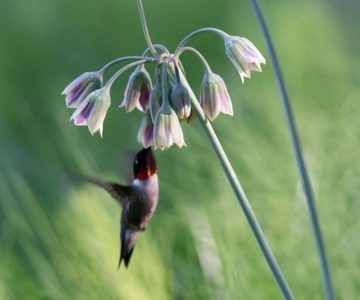
Piet Oudolf, Reimagined
Mar 31, 2021 | | LeisureDedicated local gardener Tony Spencer channels the aesthetic of the famed Dutch plantsman into his corner of the rural countryside of Mono.
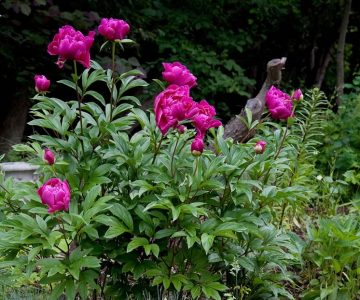
Accidental Gardeners
Mar 24, 2020 | | LeisureWith trial, error, dumb luck – and joy – two neophytes transformed four acres of bramble and meadow into a painterly Hockley garden.
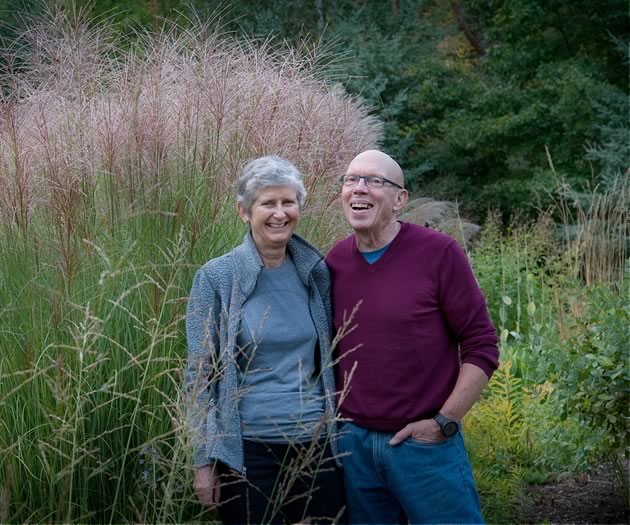
A Botany of Desire
Mar 20, 2017 | | LeisureGardener Liz Knowles’ passion for rare yet rugged alpine flora has transformed her Mono gardens into more than an aesthetic triumph. They’re an aide memoire of her life and travels 40 years on.
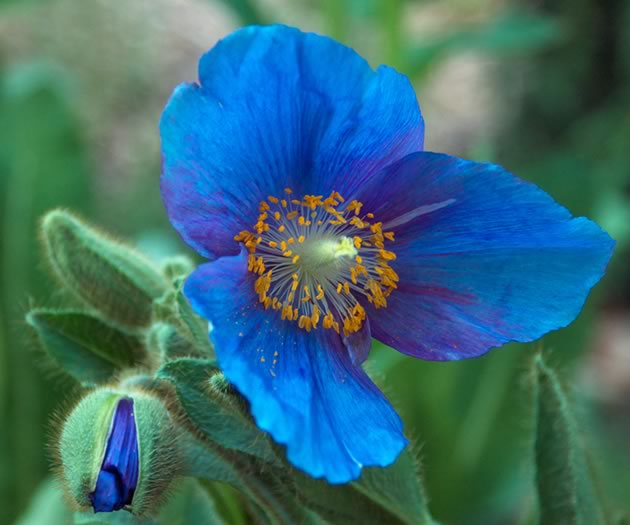
Stars of Larkspur Hollow
Mar 20, 2017 | | LeisureUp close and personal with some of the stars of Liz Knowles’ garden – many of them from alpine destinations in Central Asia, China and India.
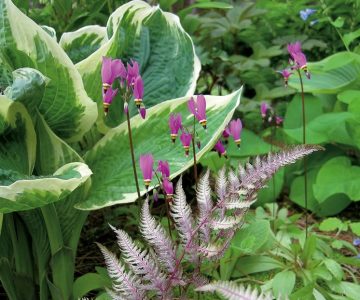
Matches Made in Heaven
Mar 21, 2016 | | LeisureHow Lorraine Roberts conjures up dreamy landscapes using colour, shape – and an appetite for surprise.



